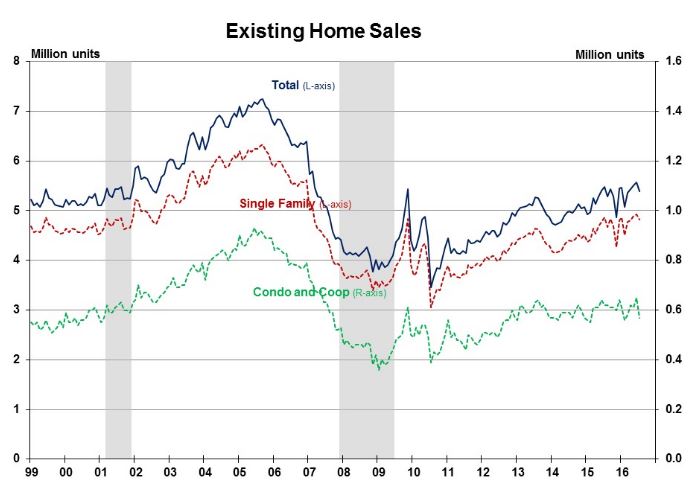 Though new home sales soared in July to their best numbers in nine years, existing-home sales in the month lost steam, slowed by low inventory levels, according to new numbers by the National Association of Realtors (NAR).
Though new home sales soared in July to their best numbers in nine years, existing-home sales in the month lost steam, slowed by low inventory levels, according to new numbers by the National Association of Realtors (NAR).
Total existing-home sales including single-family homes, town homes, condominiums and co-ops, dropped 3.2 percent in July, from June’s 5.57 million to a seasonally adjusted annual rate of 5.39 million. For the first time since last November, year-over-year sales were down as well‒‒1.6 percent off from last July’s 5.48 million.
Lawrence Yun, NAR chief economist, said existing sales fell off track in July after steadily climbing the last four months.
“Severely restrained inventory and the tightening grip it’s putting on affordability is the primary culprit for the considerable sales slump throughout much of the country last month,” Yun said. “Realtors are reporting diminished buyer traffic because of the scarce number of affordable homes on the market, and the lack of supply is stifling the efforts of many prospective buyers attempting to purchase while mortgage rates hover at historical lows.”
Ralph McLaughlin, chief economist at Trulia, said that the comparison between “yesterday’s stellar new home sales numbers with today’s existing-home sales tells an important tale of two housing markets.”
New home sales, according to the U.S. Department of Housing and Urban Development and the U.S. Census released Tuesday, showed that new home sales in July leapt 12.4 percent over June and 31.3 percent above last July.
 McLaughlin called the supply of existing homes for sale nationally “anemic.”
McLaughlin called the supply of existing homes for sale nationally “anemic.”
“Inventory fell 5.8 percent year-over-year,” McLaughlin said. “However, inventory looks significantly worse when controlling for seasonality and the number of households in the U.S. Taking seasonality and the number of U.S. households into account, existing inventory is now the lowest on record (since January 1999).”
According to NAR, total housing inventory at the end of July inched 0.9 percent higher to 2.13 million existing homes available for sale, but is still 5.8 percent lower than a year ago (2.26 million) and has now declined year-over-year for 14 straight months. Unsold inventory is at a 4.7-month supply at the current sales pace, which is up from 4.5 months in June.
“Although home sales are still expected to finish the year at their strongest pace since the downturn, thanks to a very strong spring, the housing market is undershooting its full potential because of inadequate existing inventory combined with new home construction failing to catch up with underlying demand,” Yun said. “As a result, sales in all regions are now flat or below a year ago and price growth isn’t slowing to a healthier and sustainable pace.”
The low inventory may have hurt existing-home sales, but that has resulted in gains for other areas, according to the National Association of Home Builders (NAHB).
“The severely restrained inventory of existing homes has spurred new construction and new home sales as reported yesterday,” said Stephen Melman, Director of Economic Services with NAHB. “Builder sentiment remains cautiously optimistic, brightening prospects for new single-family sales in 2016.”

 theMReport.com Your trusted source for mortgage banking news
theMReport.com Your trusted source for mortgage banking news








